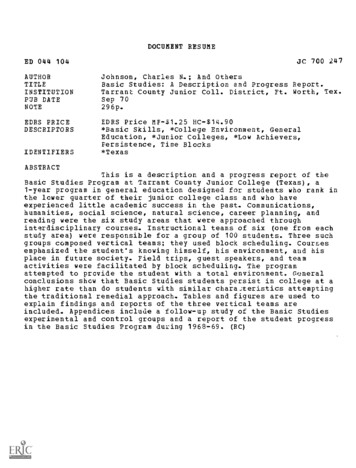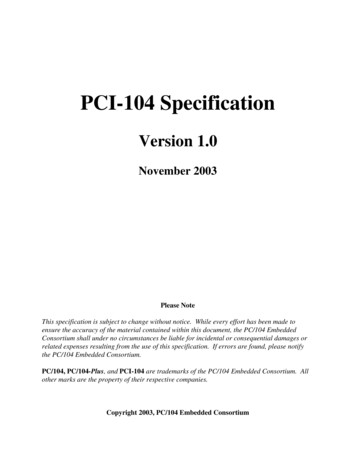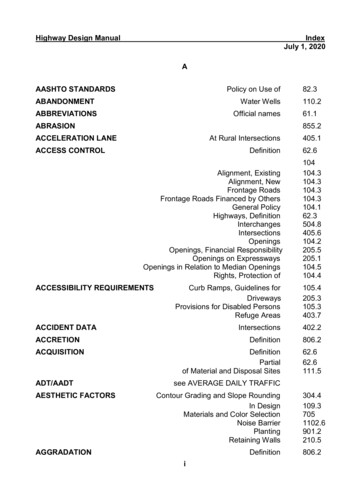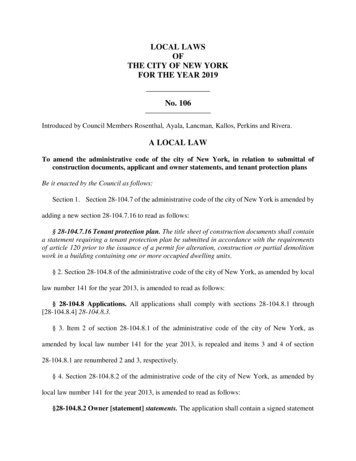
Transcription
DOCUMENT RESUMEJC 700 247ED 044 104AUTHORTITLEINSTITUTIONPUB DATENOTEJohnson, Charles N.; And OthersBasic Studies: A Description and Progress Report.Tarrant County Junior Coll. District, Ft. Worth, Tex.Sep 70EDRS PRICEDESCRIPTORSEDRS Price MF- 1.25 HC- 14.90*Basic Skills, *College Environment, GeneralEducation, *Junior Colleges, *Low Achievers,Persistence, Time Blocks*TexasIDENTIFIERS296p.ABSTRACTThis is a description and a progress report of theBasic Studies Program at Tarrant County Junior College (Texas), a1-year program in general education designed for students who rank inthe lower quarter of their junior college class and who haveexperienced little academic success in the past. Communications,humanities, social science, natural science, career planning, andreading were the six study areas that were approached throughinterdisciplinary courses. Instructional teams of six (one from eachstudy area) were responsible for a group of 100 students. Three suchgroups composed vertical teams; they used block scheduling. Coursesemphasized the student's knowing himself, his environment, and hisplace in future society. Field trips, guest speakers, and teamactivities were facilitated by block scheduling. The programattempted to provide the student with a total environment. Generalconclusions show that Basic Studies students persist in college at ahigher rate than do students with similar charaJteristics attemptingthe traditional remedial approach. Tables and figures are used toexplain findings and reports of the three vertical teams areincluded. Appendices include a follow-up study of the Basic Studiesexperimental and control groups and a report of the student progressin the Basic Studies Program during 1968-69. (RC)
TARRANT COUNTY JUNIOR COLLEGE DISTRICTSouth Campus5301 Campus DriveFort Worth, TexasU.S. DEPARTMENT OF HEALTH, EDUCATION& WELFAREOFFICE OF EDUCATIONTHIS DOCUMENT HAS BEEN REPRODUCEDEXACTLY AS RECEIVED FROM THE PERSON ORORGANIZATION ORIGINATING IT. POINTS OFW OR OPINIONS STAnD DO NOT NECESNLY REPRESENT OFFICIAL OFFICE OF EDUC. TION POSITION OR POLICYBasic Studies: A Descriptionand Progress ReportSeptember, 1970Prepared by:Charles N. Johnson, Division Chairman,and faculty of Basic FtudiesTypists:Marilyn Monger, Team Chairmanand Instructor, Social ScienceDurwood Foote, Instructor,Natural ScienceDon Hankins, Counselor andInstructor, Career PlanningJohn Rosenbalm, Instructor,CommunicationsSandra Ross, Instructor,ReadingRonald Stocker, Instructor,HumanitiesMiss Christine Kirk,Miss Karen Lance,Division SecretariesMary Lyons, Team Chairmanand Instructor,CommunicationsVon Dunn, Instructor,Natural ScienceDennis Hilton, Instructor,Social ScienceSue Scott, Asst. Prof.,HumanitiesAbe Washington, Counselorand Asst. Prof., CareerPlanningAllen Triplett, TeamChairman and Asst. Prof.,Natural ScienceJean Crow, Instructor,HumanitiesJackson Eng, Asst. Prof.,Social ScienceBill Knox, Ai5so. Prof.,CommunicationsTriesha Light, Counselorand Instructor,Career PlanningUNIVERSITY OF CALIF.LOS ANGELESNOV 18 1970CLEARINGHOUSEFORJUNIOR COLLEGEINFORMATION
DEDICATED TODr. Timothy Davies who started the Basic Studies Program;Dr. Charles McKinney and Dr. Joe B. Rushing who wanted such aprogram at Tarrant County Junior Collage;Dr. David Norton formerly of the Texas Coordinating Board, whohelped us get the program approved;and the Basic Studies Faculty who continue to make it a reality.
INTRODUCTION
A Special Program For a Special StudentThere are a number of junior colleges in Texas very interested inexperimental programs for teaching the "special" student. Dictionarysynonyms for "special' include "uncommon" and "noteworthy," but overworkedjunior college teachers sometimes declare, that these students are notuncommon, they are ubiquitous! And they sometimes exclaim that theyare not noteworthy, but as students they are not-worthy.For purposes of this report, let's agree that we are talking aboutthe students generally found in the lower one-quarter of the junior collegeclasses.Sven this definition can be confusing, because the studentschosen by this definition at Wharton or San Antonio can differ in manyrespects from the group selected on this basis from Tarrant County orEl Centro.However, we could say that the "lower one-quarter of the students"to be typified as students who:(1)Generally have a poor record of scholastic performance inhigh school.(2)Are deficient in basic skills.(3)Have poor habits of study (and possibly a poor place to studyat home).(4)Are weakly motivated, often lacking home encouragement tocontinue in school.(5)Have unrealistic and ill-defined goals.(6)Often represent homes with minimal cultural advantages andminimum standards of living.(7)Have a minimum understanding of what college requires or whatopportunities it offers.Junior college educational strategies for lower quartile studentsrange from providing no program to providing complete programs for d summersession, semester, or year. Most junior colleges in Texas offer the moretraditional remedial courses such as remedial English and remedial mathematics, yet many are finding real weaknesses in having only this approach.Attrition is high and the teaching strategies are quite often the same asthose used in high school with these students. Results are more oftenthan not unsatisfactory.
Thus many junior colleges in our state are looking for new answers.Several innovative programs for the "special" student are now being triedor at least being planned at the present time.Here at Tarrant County Junior College, an attempt is being made tobetter meet the needs of these students with a program called BasicStudies.The Basic Studies program is a one year program in general education.Within this program the student is placed in a dynamic environmentwhich provides individualized attention by instructors and stimulatesclose personal association among students.There are six areas of study:Communications, Humanities, Social Science, Natural Science, Career Planning,and Reading.The courses are interdisciplinary and the planning crosses traditional departmental lines. There are no departments in the program, butrather vertical teams have been established consisting of six instructors,Each team (there areone from each of the areas previously mentioned.presently three on the South Campus and one on the Northeast) is responsiblefor the educational activities of approximately 100 students, divided intofive sections called blocks.Each team plans the integration of the courses and the activitiessuch as guest speakers and field trips. The schedule is flexible, allowingfor large group presentation times as well as small group discussionsessions. The approach is one of total involvement rather than a segmented,departmental one.Instructors in the Basic Studies program devote full time to it andare assigned to the division of Basic Studies rather than to the universityparallel departments.They all spend considerable time in team planningand individual counseling in addition to researching and exploring howto teach their courses in new, exciting, innovative ways.Representative units in Basic Studies include "Who Am I?" "Where DidI Come From?," and "Where Am I Going?" The courses are not designed,necessarily, to get the student "ready" for any other courses, but rathertaught as if the student might never take another college course. Emphasisis upon the student learning more about himself, his immediate environment, his place in our future society. He is exposed to new points ofview and new experiences with the hope that he will profit from BasicStudies regardless of what the future offers.Redirect ion of vocational aspirations plays an important role inthe program. Three trained counselors teach the Career Planning courseand work closely with students in planning for the future. Success canbreed success, and the Basic Studies program at Tarrant County has beenproving this since its beginning in the fall of 1967. The followingreport is a revision and updated version of our first progress report ofDecember, 1968.
TABLE OF CONTENTSPageCHAPTER ONE"TARRANT COUNTY JUNIOR COLLEGE"HistoryThe ChallengeCHAPTER TWO11- "STUDENT CHARACTERISTICS"CHAPTER THREE - "PHILOSOPHY:GOALS AND OBJECTIVES"IntroductionObjectivesConclusionCHAPTER FOUR1518151522- "DESCRIPTION OF PROGRAM"23Physical StructureCourse OfferingsStudent ScheduleThe CurriculumInnovation and ExperimentationThe Counselor's RoleThe Reading LaboratoryCo-curricular ActivitiesTotal Environmental Press232627283133353536CHAPTER FIVE- "BASIC STUDIES FACULTY"HumanitiesNatural ScienceCareer PlanningCommunicationsSocial ScienceGeneral Faculty Responsibilities39424243Specific Faculty Responsibilities. .,44444545Vertical Team Chairman Responsibilities47CHAPTER SIX- "PROGRAM EVALUATION"Student PerceptionsPersistence in Basic StudiesCollege CreditsAccumulative Grade Point RverageAcademic StandingEvaluation Summary49495860616364
MULE OF CONTENTS (CON'T)PageCHAPTER SEVEN - "FOLLOW UP OF FORMER STUDENTS"CHAPTER EIGHT"THE COURSE OF STUDY"Synopsis Of Each CourseObjectivesCHAPTER NINEUnit- "VERTICAL TEAM REPORTS, FALL 69-70"- Who Am I?677979828789Vertical Team OaeSocial ScienceCareer PlanningNatural l Team TwoCommunicationsNatural ScienceSocial ScienceCareer PlanningHumanities101101104107110112Vertical Team ThreeNatural ScienceSocial ScienceCommunicationsHumanitiesCareer Planning115115118122126129Reading Lab Evaluation134Unit II- Where Did I Come From?139Vertical Team OneSocial ScienceCareer PlanningNatural ScienceCommunicationsHumanities.147151Vertical Team TwoCommunicationsNatural ScienceSocial ScienceCareer PlanningHumanities153153155157159162139139142144
TABLE OF CONTENTS ( CON'T)Vertical Team ThreeNatural ScienceSocial ScienceCommunicationsHumanitiesCareer PlanningReading Lab EvaluationCHAPTER TEN"VERTICAL TEAM REPORTS, SPRING '70"Page1641641661b9173175179183Unit III - Societal Issues185Vertical Team OneSocial ScienceCareer Planning.Natural ScienceHumanities185185188191194Vertical Team TwoCommunicationsNatural ScienceSocial ScienceCareer PlanningHumanities196196200206208209Vertical Team ThreeNatural ScienceSocial ScienceCommunicationsHumanitiesCareer Planning212212214216219223Unit IV229- Society of the FutureVertical Team One229Vertical Team TwoCommunicationsNatural ScienceSocial ScienceCareer PlanningHumanities232232235236238241Vertical Team ThreeNatural ScienceSocial ScienceCommunicationsHumanities242242247250253
TABLE OF CONTENTS (CON'T)Feeding Lab EvaluationCHAPTER ELEVEN - "DECISIONS AND PROBLEMS"DecisionsSpecific Problem AreasAPPENDIX A- "EXPERIMENTAL AND CONTROL GROUPS, A FOLLOW-UPSTUDY"APPENDIX B- "STUDENT PROGRESS REPORT, 1968-69"Page254263263268
e""Level of Aspiration""Vocational Choice""High School Grades""ACT Standard Scores""ACT Composite Predictor Scores""Student Evaluation of Program Components""Student Evaluation of Program Needs""Student Evaluation of Selected Activities""Persistence in Basic Studies""College Credits - Fall 1969""College Credits - Spring 1970""Fall Semester - Grade Point Averages""Spring Semester - Grade Point Averages""Academic Standing - Fall Semester 1969""Academic Standing - Spring Semester 1970""GPA Range in Other Programs - Fall""CPA Range in Other Programs - Spring""Results of Dignostic SGraphGraphGraphGraph1234"Sequential Reading Test Results - Fall, 1969""Reading Tests - Team One""Reading Tests - Team Two""Reading Tests - Team Three"181258259260FIGURESFigure 1Figure 2Figure 3FigureFigureFigureFigure4567"Sample Block Schedule""Vertical Team Integration ChartUnit I - Who Am I?""Vertical Team Integration ChartPersonality of a City""Unit I - Who Am I?""Unit II - Where Did I Come From?""Unit III - Societal Issues""Unit IV - Society of the Future"24303288138184228
CHAPTER ONE"Tarrant County Junior College"Understanding the successes and failures of an experimentalprogram is difficult unless specific features of the environmentin which it operates are understood. Therefore, the first chapterof this progress report will present the facts and figures whichdemographically illustrate the Tarrant County Junior College District in Fort Worth, Texas.HistoryTarrant County Junior College District was formed by thevoters of Tarrant County on July 31, 1965. By November 1, 1965, aseven member board of trustees had been appointed, and Dr. Joe B.Rushing assumtd the position of President of the District.Local revenue which supports this Junior College Districtcomes from ad valorem taxes levied on property assessed at 785,000,000 as of 1966 (estimated to be twenty-five percent of actualvalue).The Board of Trustees is authorized to levy a tax up totwenty cents on 100 for operation.For support and operationthe District will also receive 400 per full-time equated studentfrom state sources.1By September 1967, the doors of the South Campus, the firstof a proposed three campus county structure, opened.Through theforesight of the community, the board of trustees, and the administrative officers, the South Campus had all buildings in operationfor its first academic year.Unlike many junior colleges startingfrom scratch, Tarrant County Junior College opened with a studentcenter, learning resources center, and a gymnasium along withtwenty-three various classroom facilities.Such a thorough startwith the physical pli.nt is superceded only by the College's philosophy of education.The ChallengeThe College's "open door" philosophy demands that no admission1Overview and Guidelines: Planning Documents for TarrantCounty Junior College District, Fort Worth, Texas.
2criteria be enforced beyond a high school diploma or its equivalent.Thus, several immediate problems are at hand, for through theseopen doors enter students aspiring toward their educational dream.This presents the open door junior college with a student populationso heterogeneous that it becomes impossible to make all students"jump the same educational hoops." Assuming then that differentgroups of junior college students need different educational programs, the greatest challenge facing juni-r college educators isone of developing an academic progra' wh tL will meet the needs ofthose students who have experienced little academic success inhigh school and have scored very poorly on the college entranceexamination.These students are not new to the educational scene, for inthe past they have been accommodated in one of four ways:(1) Theywere not accepted by the institution; (2) They were placed in theconventional liberal arts or university parallel programs; (3) Theywere placed in remedial or developmental courses and received nocollege credit; (4) They were placed in the technical, occupational,or career programs which the institution offered.If one considers these four attempts at a solution to thisproblem, he becomes easily disenchanted with them. The very natureof the open door college has eliminated the first possibility, forall students are accepted by the college. The second method seemsequally inadequate, for it requires the academically unsuccessfulstudent to compete with the academically successful student atleast on the basis of high school performance. This makes it virtually impossible for the less capable student to complete thecourse satisfactorily, for generally he is ignored and the classis taught at a level beyond his comprehension.The third attempt at a solution is a good idea if one considersthat its initial purpose was to aid students who are deficient inone particular area, yet academically capable to succeed in otheruniversity parallel courses. However, the ideal degenerates to thereal, and these classes are filled with students for whom there islittle hope.It becomes, in reality, a "weeding out" process wherethe college eliminates the academically weak after one or two semesters.The fourth approach previously mentioned seems to functionon the premise that those students who are not qualified for thecollege parallel program can certainly function in a technical2The equivalent being successful completion of the G.E.D,score which will allow a student entrance the year of his classgraduation.
3capacity because "anyone can pass a technical course." Granted,some students may complete a technical program whereas they maynever complete an "academic" program. However, the attempt tologically conclude that all students, regardless of their lackof motivation or lack of skills, envy the same success in a technical program is fallacious.In short, the attempts at solvingthis curriculum program inherent in the open door philosophy arefar from satisfactory.In fact they are making the "open door"philosophy a "revo]ving door" reality.The administrators at Tarrant County Junior College realizedthat in order to develop a comprehensive curriculum at the SouthCampus an educational program must be devised to meet the needs ofthose students who had achieved little academic success in the past.The Basic Studies Program was developed to meet the needs of thisparticular group of students.However, before any program couldbe established and its goals, objectives, and curriculum developed,it was imperative to examine in greater detail the student populationto be served.
5'CHAPTER TWO"Student Characteristics"The student population to be served by the Basic Studies Program is not unique to Tarrant County Junior College. In fact thevery nature of the open door philosophy encourages the entrance ofjunior college students with the following characteristics:1.The student is a first semester applicant to TarrantCounty Junior College.2.The student desires a full-time, day schedule.3.The student is between seventeen and twenty-one years ofage.This criterion was added because the program isexperimental and designed to accommodate approximately300 students.Since there were many more students whomet all criteria, the decision was made to work with theyounger students.4.The student scores below the 25th percentile on theThe 25th percenAmerican College Test composite score.tile is the maximum score for the Basic Studies ProgramHowever,and was arrived at through educated guessing.it is now being more thoroughly researched.5.The student indicates that his level of aspiration is anAssociate of Arts Degree or beyond. The level of student aspiration is determined through the profile sheetof the American College Test. This criterion eliminatesthe student who desires a technical or vocational program and scores below the 25th percentile on the ACTcomposite. As this report indicates later on, this isnot necessarily the best approach; but it was the approachused during our first three years.6.The student achieved little academic success in highGenerally this indicates that the studentschool.achieved a "C" average or below while in high school.The majority of the students had an accumulated highschool grade point average of 1.9 or below based on aIt was also determined that ten perfour point scale.cent of the students enrolled in the Basic Studies Program did not receive a high school diploma but insteadpassed the G. E. D. equivalency examination.
6The two key factors in the selection of Basic Studies students are their ACT composite score and their level of aspiration.The ACT composite score considers the last semester of high schoolgrades, which generally would refer to the first or second semesterof the junior year; the student's standard score achievement onthe test itself; and the local norms which have been establishedin the Texas junior college system. However, one would always beable to generalize this student population by converting the ACT01-12 standard score or the college bound percentile score toanother national entrance test.The level of aspiration is a key factor because it generallyindicates unrealistic educational goals.The students served bythe program are weak in the basic skills as evidenced by their pastacademic performance and a battery of academic skill testsgiven during orientation.Yet they are in no way interested in atechnical or occupational field. Burton Clark explains that thistype of student is found in all open door junior colleges. It ishis belief that many students who matriculated in. September at ajunior college declare themselves to be transfer students; yet theynever transfer, but neither do they finish a terminal program. Inthe following statement Clark labels these students "latent terminal" and stresses the need to develop new and exciting programsfor them.The basic problem in the Junior College isthe processing of the student who falls between the transfer and terminal groups.Students with transfer intentions for themost part do not transfer, but neither dothey complete the terminal curricula. Mostterminate their education while in collegebut do so as drop-outs while pursuing transfer workthe administration of curriculum and instruction is centrally concernedwith the processing of this in-between.The battle of the production line in thejunior college is to hold on to a good shareof these students long enough to train themfor an occupation or to add to their generaleducation.3.In further support of the need of special programs for thisgroup of students, Dr. Leland Medsker reports that nationally only3Burton R. Clark, The Open Door College (New York:Hill Book Co., Inc., 1960), p. 84.McGraw-
7about 1/3 of the students who enroll in transfer curricula dotransfer. In other words, the junior college system is failingto provide meaningful educational programs geared to affect theperson.4Since Tarrant County Junior College is a new institution without tradition and red tape, an excellent opportunity is at hand.By recognizing the existence of this particular group of studentsand through a commitment to an experimental program, a very significant st.tu:t was made.Yet, even with the amount of national research available, all showing this common weakness in curricula,an experimental program must be evaluated in light of the localstudent population which it services.Attempts were made to not fcrce any student into the BasicStudies program against his will. Admittedly, the choices open tothe student if he did not choose Basic Studies were rather limited,for he had to select one of the following three educational plans:He would register for remedial or non-credit courses. (2) He(1)would enroll in a technical program which according to his levelof aspiration on the ACT did not interest him. (3) He couldbecome a part time student and select courses from the schedule atSince the Basic Studies program assists the student inrandom.earning 32 hours of college credit, the advantages of selecting thisprogram are obvious.The remainder of this chapter consist:: of data concerning thestudents in the Basic Studies program during the 1969-70 academicThis data should enable the junior college administrator toyear.compare student groups at Tarrant County with his own student population.TABLE 1SEX DISTRIBUTIONTotal 309MaleFemale22089As expected the male population was almost three times greaterthan the female. This is somewhat indicative of the total JuniorCollege enrollment pattern at Tarrant County and across the nation.4Leland M. Medsker, The Junior College: Progress and Prospect (New York: McGraw-Hill Book Co., Inc., 1960), p. 112.
8TABLE 2RACEMaleFemaleWhite15543Negro603957Latin AmericanThere was a larger percentage of black students in Basic Studiesthan the total college (33% to 10%) allowing for much discussion andThere was at timesstudy of problems relating to race relations.some discussion among black students on campus about Basic Studiesbeing a program where "all the blacks were placed." Statistics showthis to be untrue, but attempts are made in Basic Studies to studymany aspects of the black man's contributions to our society and wayof life.For many Jtudents, both black and white, it was the firsttime they had been in class together, but after a few weeks of classes,Also a largerthe group members intermingled regardless of race.Latin American population was expected; however, there have beenrelatively few students of Latin American background in the entirecollege.A study is now under way to try to determine the reasonsfor this situation.TABLE 3LEVEL OF ASPIRATIONNumberVocational orTechnical ProgramJunior CollegeDegreeB. A. Degree orEquivalentM. A., Ph.D.,LLB., DDS., etc.Undecided951141690INo Data38
9This information on level of aspiration wa3 taken from counseling information cards filled out by the students prior to theirentrance into the Basic Studies program. Regardless of the students'past experience in education or their ability level, many stillrecord an extremely high level of aspiration. For many, this is notan indication of what the student really wants to accomplish butrather what he thinks we as educators want him to accomplish.The real importance of this aspect of the stlidy is to measurethe vocational choice at the end of one year of education to determine whether or not the student has changed his vocational selectionto one which is more academically realistic. Approximately 125students in the Basic Studies program this past year (69-70) indicateda vocational choice at the end of the year that showed a definiteThie group had aspired toward achange in level of aspiration.B. A. degree or beyond before the program, but indicated they nowplanned to work toward a two year degree or one year certificateFor most this was a much more realistic vocational choiceprogram.after extensive counseling in Basic Studies than before.Other students also made definite vocational choices afterbeing undecided upon entering the program. Table 4 gives a summaryof vocational choices made by students in Basic Studies this pastyear.TABLE 4VOCATIONAL CHOICEAssociate in Arts Degree79Associate in Applied Science81 (total)DraftingAuto MechanicsCom. TransportationTeacher AideMid ManagementFashion MerchandisingMedical TechnologyRefrig. - Air Cond.Auto TechnologyAerospace TechnologyOffice OccupationsChild CareElectronicsBroadcast Communications121121113525337133
10TABLE 4 (continued)VOCATIONAL CHOICEMilitaryOne Year CertificateClericalBusinessData Processing725 (total)1285Transfer10Training Programs Outside TCJC21 (total)NursingCivil ServiceAirlinesTV RepairTech. DraftingCarpentryDept. of AgricultureSecretarialTelephone ServiceBusinessBarber CollegeWelding521111111511Undecided15No Data at Present55More will be said about our success in vocational redirectionPrein the later chapters on program evaluation and team reports.liminary reports indicate, however, that we were more successful inour counseling this past year than we were in 1968-69 when we feltthat too many students with very little academic potential chose togo into the university parallel program.
11TABLE 5HIGH SCHOOL Social Science552150687Natural Science631142747*These letter grades are the student's report on the ACT ofhis most recent high school term grades prior to his senior year inEnglish, mathematics, social studies, and natural sciences.The data indicates that the majority of the students in BasicStudies earned C and D averages in most of their courses in high school.There were those who earned B's and even a few A's, but for the mostpart there was a general lack of success academically. This lack ofsuccess in high school places an added challenge on the instructorsand curriculum developers.TABLE 6ACT STANDARD SCORES(Composite)Scores0 - 5No. of Students28- 108711 - 1513016 - 204521 - 2526Not Available17
12The ACT testing program requires the student to take four testain the areas of English, math, social science, and natural science.On each of these four tests the total number of correct responsesyields a raw score.This raw score is converted into a standardscore ranging from one to thirty-six, which is the maximum. In addition to the four areas of testing, ACT also has a composite scorewhich is derived through averaging the scores of the four tests.Table 6 illustrates the composite standard scores of students in theBasic Studies program in 1969-70. About 79% of the students in ourprogram scored below fifteen on this aspect of the ACT, indicatingdefinite weaknesses in their academic preparation for college.TABLE 7ACT COMPOSITE PREDICTOT SCORESPredictor Bands0 - 5No. of Students1296 - 104411 - 153016 - 20221 - 252925 or aboveNot available669The ACT composite predictor score is derived from a student'shigh school grades as reported on the ACT Profile Analysis and thestandard score which represents the student's achievement on the ACTThe students in Basic Studies, with very few exceptions, falltest.below the 25th percentile on this score which indicates their predicted chances for success in a traditional liberal arts or universith parallel curriculum are very low.In selecting candidates for Basic Studies, we examine both theACT standard composite scores and the predictor scores. If a studentscores thirteen or below on the composite, he is eligible for the program; or if a student scores below the 25th percentile on the predictorportion, he is also a candidate. Should a student fall into both ofthese categories, he is strongly advised to enter the Basic Studiesprogram.
13Once the initial problem has been identified and the characteristics of the students have been determined, it is then time for the program developer to establish the goals and objectives that his programis to accomplish. The goals and objectives of the Basic Studies program will be explained in Chapter Three.
15CHAPTER THREE"Philosophy:Goals and Objectives"IntroductionQuite often one of the weakes
DOCUMENT RESUME ED 044 104 JC 700 247 AUTHOR Johnson, Charles N.; And Others TITLE Basic Studies: A Description and Progress Report. INSTITUTION Tarrant County Junior Coll. District, Ft. Worth, Tex. PUB DATE Sep 70 NOTE 296p. EDRS PRICE. EDRS Price MF- 1.25 HC- 14.90. DESCRIPTORS *Basic Skills, *College Environment, General










